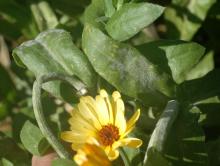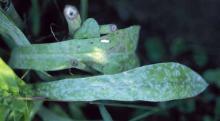Cause Powdery mildew has not been reported formally for the Pacific Northwest, but it is a common garden problem west of the Cascade Range. Golovinomyces cichoracearum (formerly Erysiphe cichoracearum) has been reported from California. This fungus is favored by conditions that produce high humidity but dry leaves. It is a highly specialized pathogen that forms a close association with the host. Conditions that favor the host also favor the pathogen. Much of the fungus remains outside infected plant parts where it grows on the surface but sinks root-like structures called haustoria into plant cells to obtain nutrients. The white growth seen is composed of both mycelium and fungal spores.
Symptoms Frosty white, powdery spots develop on leaves. Colonies can become so extensive that the entire plant may appear white.
Cultural control
- Space plants for good air circulation.
- Remove and destroy infected plants.
- Plant in sunny open locations rather than in shady areas.
Chemical control Fungicides will do best when used before symptoms develop. Few materials have good eradicant activity. Use at 7- to 14-day intervals; using shorter intervals when environmental conditions favor disease development. Alternate or tank-mix products from different groups that have different modes of action. Minimize the use of any one group during the growing season.
- Armada 50 WDG at 3 to 9 oz/100 gal water. Do not use a silicone-based surfactant. Not for nursery or greenhouse use. Group 3 + 11 fungicide. 12-hr reentry.
- Eagle 20 EW at 6 to 12 fl oz/100 gal water. Group 3 fungicide. 24-hr reentry.
- MilStop (85% potassium bicarbonate) at 2.5 to 5 lb/A in the field or 1.25 to 5 lb/100 gal water in the greenhouse. Might supplement a normal program when powdery mildew is first observed. Do not mix with other pesticides. Thorough coverage is essential. Oregon and Washington only. 1-hr reentry. O
- Monterey Bi-Carb Old Fashioned Fungicide is registered for home use at 4 teaspoons/2 gal water. H
- Myclobutanil 20 EW T&O at 6 to 12 fl oz/100 gal water plus spreading agent. May observe a PGR effect. Group 3 fungicide. 24-hr reentry.
- Ortho Rose & Flower Disease Control at 2 fl oz/gal water. Group 3 fungicide. H
- Propiconazole-based products. Group 3 fungicides.
- Banner MAXX at 5 to 8 fl oz/100 gal water. 12-hr reentry.
- Infuse Systemic Disease Control at 1 Tbsp/gal water. H
- Systemic Fungicide (ferti-lome) at 0.5 fl oz/gal water. H
- Regime at 20.5 to 45.7 fl oz/A. Group BM01 fungicide. 4-hr reentry.
- Seido at 4 to 5 fl oz/100 gal water plus an adjuvant. Group 50 fungicide. 4-hr reentry.
- Spectracide Immunox Multi-Purpose Fungicide Spray Concentrate for Gardens at 1 fl oz/gal water. Group 3 fungicide. H
- Terraguard SC at 4 to 8 fl oz/100 gal water. Group 3 fungicide. 12-hr reentry.
- Thiolux (80% sulfur) at 3 to 10 lb/A. Group M2 fungicide. 24-hr reentry. O
Reference Braun, U. and Cook, R.T.A. 2012. Taxonomic Manual of the Erysiphales (Powdery Mildews). CBS-KNAW Fungal Biodiversity Center, The Netherlands.



